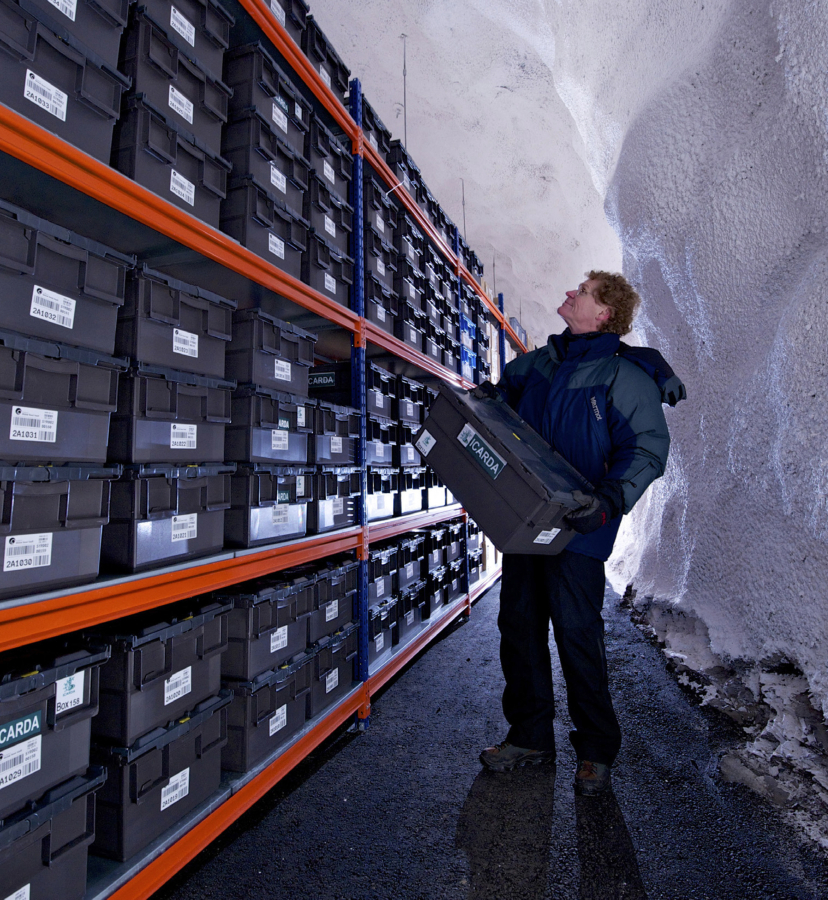The Svalbard Global Seed Vault is not exactly at the North Pole, but it’s nearer to it than just about anywhere else, and well inside the Arctic Circle on the Norwegian archipelago of Svalbard. This beguiling structure juts out from a mountain near the town of Longyearbyen, which is reputed to be the northernmost permanent settlement on Earth and a place where residents must go about their business with rifles slung over their backs, on account of the polar bears. The sun falls below the horizon on Nov. 14 and isn’t seen again until March 8.
It is precisely this remoteness and coldness that led scientist Cary Fowler and his colleagues at the Global Crop Diversity Trust, now known as the Crop Trust, to persuade the Norwegian government to locate the vault there. Almost nine years after it was built, the seed vault has taken on a mythic quality around the world, perhaps because its entrance — stark, geometric, bejeweled by a light sculpture by Norwegian artist Dyveke Sanne — hints at something not just hidden but forbidden. Bauhaus meets Valhalla.
Fowler, with principal photographer Mari Tefre, has just written a book on the vault that lifts the veil on the place — it’s not open to the public even though it quickly became the second most recognized structure in Norway. The book is called “Seeds on Ice.”
Svalbard’s beguiling paradox of fame and mystery inevitably has spawned various wacky conspiracy theories, including the idea that the vault is a top-secret NATO facility housing a global eugenics project. Fowler hopes the book will dispel a more mainstream misapprehension, that this is a doomsday vault, a time capsule to unlock after a nuclear Armageddon.
The vault today houses more than half a billion seeds representing 881,473 unique varieties of plants used to feed people. The seeds come from the existing seed banks in 233 countries, and they are insurance against the loss of an irreplaceable crop to something as unexciting as a budget crisis in a poor country (or a rich one) to, yes, a cataclysmic nuclear war.
Each seed has its own genetic makeup, and the value of these stocks is in their DNA. If a new disease or pest were to wipe out a strain of wheat, for example, it’s probable that the germ plasm at Svalbard could be used to breed in resistance. Climate change poses another tangible threat, as extreme weather events, rising waters and shifts in temperatures require the development of new varieties to handle the challenges.
In part, the Svalbard vault is best understood by what it is not: It is not a vast subterranean laboratory staffed with the world’s boffins in white coats, a la CERN or a James Bond movie. It is a hole in a mountain, a tunnel that extends a few hundred feet and terminates in three chambers, each 90 feet long, 30 feet wide and 16 feet high. Only one is in use at the moment.
It is simple, relatively cheap to run, and designed to withstand physical calamity and human interference. It is meant to last a thousand years or more.
It is not permanently staffed, though it is constantly monitored and the seeds are housed behind at least five locked doors. You couldn’t just show up and loiter with intent. You would be noticed by the local police, or the controllers in the distant airport tower or the polar bears.
Nor is it a time capsule. The seeds are very much alive and available for use today, if needed.
Unfortunately, that has come to pass with the tragedy that has befallen Aleppo. The Syrian city held the seed bank of the International Center for Agricultural Research in the Dry Areas (ICARDA) and contained vital stocks of such staples as wheat, barley, chickpeas and fava beans.
The staff there sent seeds to Svalbard just months before the engulfing civil war. Last year, Svalbard returned many of the seeds to new ICARDA facilities established in Morocco and Lebanon, where scientists and farmers are now growing them to regenerate seed.
The threats to our food supply are often far less stark but no less real. Fowler says agriculture faces “its most severe set of challenges since the Neolithic period.” Besides climate change, this includes the need to grow more food for a growing population using fewer resources. One contemporary approach to this is the development of genetically modified organisms by multinational biotech companies. The vault doesn’t contain GMOs, though Fowler’s stance on this is not strictly in opposition to transgenic breeding. His interest, instead, is in conserving all the natural genetic diversity embodied in these seeds as insurance for our food supply in the centuries to come.
In the early ’90s, Fowler, a native Tennessean, was recruited by the U.N.’s Food and Agriculture Organization to oversee a review of the world’s crop diversity and found many national seed collections in dire states of storage and care. He has since left the directorship of the Global Crop Diversity Trust, though he remains an adviser to the trust and is chair of the seed vault’s International Advisory Council.
Fowler has been immersed in this field for decades, but Svalbard made him realize, he said, that many of the world’s agricultural crops are not familiar even to experts. What, you might ask, is sesbania, or Chihuahuan snout-bean or voa vanga?
The point is that tastes and crops change — how many gardeners in the United States were growing bok choy or arugula 50 years ago? “People look at the seed vault and see it as a conservation initiative,” he told me. “But those of us in the field have multiple motivations. The reason for wanting to conserve it isn’t to make us feel good but have it be of use in the future.”



